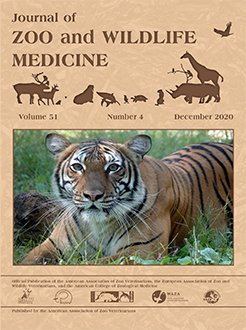Ophthalmic studies of the Texas tortoise (Gopherus berlandieri) established normal ophthalmic parameters for select diagnostic tests in captive tortoises and assessment of differences among individuals of differing size and health status. Sixty-one tortoises of varying weight, shell size, Mycoplasma seroprevalence, and herpesvirus exposure were included. Complete ophthalmic examinations, including neuro-ophthalmic reflexes, phenol red thread test, rebound tonometry, fluorescein staining, palpebral fissure length measurement, slit lamp biomicroscopy, indirect fundoscopy, and ocular ultrasound measurements of axial globe length, anterior chamber depth, lens thickness, and vitreous length, were recorded. All tortoises had negative dazzle and pupillary light reflexes, inconsistent menace responses, and positive palpebral reflexes. Mean ± SD tear production and intraocular pressure (IOP) were 14.2 ± 5.6 mm/15 sec and 13.8 ± 2.4 mm Hg in healthy tortoises, respectively. Mycoplasma-seropositive tortoises (with or without herpesvirus exposure) had significantly increased tear production (20.2 ± 8.1 and 19.9 ± 8.9 mm/15 sec, respectively) compared with healthy seronegative tortoises (14.2 ± 5.6 mm/15 sec; P = 0.02). As body size decreased, so too did palpebral fissure length and ocular ultrasound measurements, while IOP increased. Overall, palpebral fissure length appeared relatively small, and tear production relatively increased compared with other chelonian species, likely on the basis of the relatively arid native habitat. Further work is recommended to establish baseline values in related species, as well as comparison in aquatic versus terrestrial chelonians. The authors further suggest that the finding of relatively increased tear production in tortoises may indicate the need to rule out mycoplasmosis as a cause of upper respiratory tract disease.
How to translate text using browser tools
12 January 2021
CLINICAL OPHTHALMIC PARAMETERS OF THE TEXAS TORTOISE (GOPHERUS BERLANDIERI)
Kate G. Rowatt,
Erin M. Scott,
J. Jill Heatley
ACCESS THE FULL ARTICLE





